Diego Almendras is a marine biologist, and try to contribute to bridge the gap between Science and People, writing about marine science, biology, and everything related to oceans.
Don't wanna be here? Send us removal request.
Text

KILLER WHALES CRAFT KELP TOOLS FOR SOCIAL GROOMING
In a remarkable discovery, researchers have documented wild Resident killer whale (Orcinus orca ater) manufacturing and using tools in a social context. Observed in the Salish Sea from April to July 2024, members of the endangered southern resident population were seen detaching short lengths of bull kelp (Nereocystis luetkeana) and using them during tactile interactions with a partner, a behavior the authors call allokelping. This behaviour differs from playful kelp draping commonly seen in cetaceans, whales in this study deliberately fashioned kelp segments using their teeth, positioned them between their bodies, and coordinated their movements to roll the kelp across one another’s skin.
This represents a potential case of tool-assisted allogrooming, a behaviour rarely documented in non-primates and never before in marine mammals. Statistical analyses suggest that allokelping may serve both hygienic and affiliative functions, being more common among close kin and individuals of similar age, and possibly linked to skin molting. The whales’ use of their entire bodies, rather than limbs, to manipulate the kelp, and the mutual benefit of the interaction, make this a unique form of tool use in the animal kingdom. If confirmed, it would expand our understanding of cetacean intelligence, culture, and the evolutionary roots of cooperation.
Photo: Orca grasps a bull kelp stalk by the holdfast end and detaches a short stipe segment for use in allokelping.
Reference (Open Access): Weiss et al., 2025. Manufacture and use of allogrooming tools by wild killer whales. Current Biology.
#Orcinus orca ater#orca#Nereocystis luetkeana#bull kelp#allokelping#allogrooming#science#biology#behaviour#marine biology#sciblr#scienceblr
1K notes
·
View notes
Text


BULL SHARK SWIMS 7,290 KILOMETRES IN RECORD MIGRATION
A recent study revealed that a female bull shark (Carcharhinus leucas) travelled at least 7,290 kilometres from the Mozambique Channel to Nigeria, crossing from the Indian Ocean into the Atlantic in what is now the longest recorded movement for this species. The finding was made possible by an acoustic transmitter implanted in South Africa in 2021 and recovered when the shark was captured near Lagos in July 2024. Bull sharks have long been considered coastal residents with relatively limited movements and a strong preference for warm, estuarine environments, making this ocean-crossing journey a remarkable exception that challenges previous assumptions about their ecology.
The shark’s route included passing through the Benguela upwelling, a major cold-water system along the coasts of South Africa and Namibia that has traditionally served as a biogeographic barrier for tropical species. Researchers suggest that climate change, by altering the temperature and dynamics of such systems, may be enabling new migratory pathways for widely distributed marine animals. In addition to expanding our understanding of bull shark ecological flexibility, this event highlights the value of large-scale acoustic tagging programmes and international collaboration in tracking the movements of highly mobile and potentially vulnerable species.
Main photographs: Bull shark by Ingo Rogalla. And fisherman from Lagos, Nigeria, reported capturing a female bull shark with an internal acoustictransmitter. The shark was originally tagged on 2 April 2021 at the St Lucia Estuary mouth on the east coast of South Africa. Photo credit: Mr. Akeem Kolawol.
Reference: Daly et al., 2025. Breaking barriers: Transoceanic movement by a bull shark. Ecology.
#africa#atlantic#indian ocean#science#migration#ecology#shark#elasmobranch#bull shark#Carcharhinus leucas#biology#marine biology#sciblr
295 notes
·
View notes
Text

DEEP-SEA DOMINANCE: THE SUPERGIANT AMPHIPOD ACROSS THE ABYSS
The deep-sea amphipod Alicella gigantea, described in 1899, currently known as the world’s largest amphipod, inhabits depths of the lower abyssal and upper hadal zones. Historically, it has been sampled or observed in situ infrequently relative to other deep-sea amphipods, suggesting low population densities and providing a sense of rarity. Consequently, little is known about the demography, genetic variation and population dynamics of A. gigantea.
Although elusive, Alicella gigantea is one of the most widely distributed amphipods known, thriving across more than half of the world’s oceans, according to a recent study by researchers at the University of Western Australia. Amphipods like A. gigantea are shrimp-like crustaceans with narrow bodies and a distinctive hunched posture. They inhabit nearly every aquatic habitat on Earth, from shallow coasts to the hadal trenches, though their numbers dwindle with increasing depth.
In the most comprehensive assessment to date, scientists compiled 195 records from 75 locations across the Pacific, Atlantic, and Indian Oceans, including both published data and new expeditions. Genetic analysis of mitochondrial and nuclear genes revealed extremely low divergence among global populations, supporting the existence of a single, globally distributed species. The haplotype network showed minimal regional differentiation, with shared haplotypes across vast distances and the Pacific identified as the species’ main stronghold. Far from being rare, A. gigantea occupies nearly 60% of the global ocean, a silent giant spanning the deep.
Main photograph: The supergiant amphipods. Oceanlab, University of Aberdeen, UK.
Reference (Open Access): Paige et al., 2025. The supergiant amphipod Alicella gigantea may inhabit over half of the world’s oceansR. Soc. Open Sci.
21 notes
·
View notes
Text

PENGUIN SCAT LINKED TO CLOUD FORMATION AND ANTARCTIC COOLING
In Antarctica, a team of scientists has discovered that Adélie penguins might unknowingly be helping to reduce some effects of climate change. Their guano, rich in ammonia, releases this gas into the atmosphere, where it can contribute to cloud formation. These clouds can act like a shield, cooling the surface and helping to preserve sea ice—a critical component of the Antarctic ecosystem.
During a recent expedition to Antarctic Peninsula, researchers from the University of Helsinki measured ammonia levels in the air and found they spiked when winds came from a colony of 60,000 Adélie penguins. Even after the penguins migrated at the end of summer, the guano left behind continued to release ammonia, keeping levels unusually high.
This discovery shows that seabirds are not only vital to ecological balance, but may also play an unexpected role in atmospheric processes that influence climate. Protecting these animals and their habitats could have broader benefits than we once thought—extending all the way to how the Earth responds to warming.
Main photo: leekelai
Reference (Open Access): Boyer et al. 2025. Penguin guano is an important source of climate-relevant aerosol particles in Antarctica. Commun Earth Environ.
27 notes
·
View notes
Text

A RARE GLIMPSE INTO KILLER WHALE AND PILOT WHALE CALF BEHAVIOR IN ICELAND
Off the coast of Iceland in 2023, researchers witnessed a rare and intriguing encounter between a group of killer whales and a neonate long-finned pilot whale calf. The calf was seen swimming closely beside an adult female killer whale, maintaining an echelon position for over an hour. The group moved slowly at first, but later sped up, with the calf appearing to try to evade the killer whales. In a surprising moment, an adult killer whale was observed lifting the calf out of the water, an extraordinary behavior caught on camera.
While killer whales are known predators of pilot whales in some regions, the individuals involved in this encounter are generally fish-eaters, feeding mainly on herring. There were no signs of aggressive attacks or injury to the calf, and the behaviors resembled non-predatory interactions documented in other dolphin species. These encounters can include play, social exploration, or practice hunting, highlighting the complex and varied social lives of killer whales and their interactions with other marine mammals.
Though the pilot whale calf was not seen again after this event, the observation provides valuable insight into cetacean behavior and challenges our understanding of predator-prey dynamics in the ocean. It also underscores the importance of continued research in these waters, revealing how much there is still to learn about the subtle and surprising relationships among marine species.
Main photo: A neonate long-finned pilot whale surfaces in echelon position next to an adulto female orca. Photo by Filipa Samarra.
Reference: Baumgartner et al., 2025. Interactions Between Killer Whales (Orcinus orca) and Neonate Long‐Finned Pilot Whales (Globicephala melas) off South Iceland. Ecology and Evolution.
#long-finned pilot whale#globicephala melas#orca#orcinus orca#science#biology#marine biology#marine science
34 notes
·
View notes
Text

FIRST-EVER FOOTAGE OF INDONESIAN COELACANTH IN NORTH MALUKU REVEALS NEW INSIGHTS INTO RARE SPECIES
The coelacanth, often dubbed a "living fossil," is one of the most iconic and mysterious marine vertebrates. Long thought extinct until its rediscovery in 1938, only two species are known today—Latimeria chalumnae in the western Indian Ocean, and L. menadoensis in Indonesia. The latter, the Sulawesi coelacanth, lives in deep, difficult-to-access reef habitats and has rarely been observed alive. For the first time, divers using advanced technical diving equipment have filmed a live Indonesian coelacanth in situ, at a depth of over 150 metres in North Maluku, a region where the species had not previously been recorded.

Left profile of the coelacanth, with its unique pattern of white dots. Photo by Alexis Chappuis.

- Localities from whence the Sulawesi Coelacanth, Latimeria menadoensis, has been reported in black stars. White star shows the North Maluku Province, where the first in situ sighting by technical divers was made.
This sighting is more than just a milestone in exploration—it provides critical data on the ecology and distribution of an animal that is evolutionarily unique and highly vulnerable. With few individuals ever seen in the wild, each observation adds valuable insight into how these ancient fish live and where they might still be found. It also underscores the urgency of protecting deep reef habitats that are increasingly at risk from human activities. Understanding and safeguarding the ecosystems that support the coelacanth is essential if we hope to ensure its survival into the future.
Main photo: Deep diver about a meter behind the coelacanth discovered at a depth of -144 m in North Maluku, Indonesia. Photo by Alexis Chappuis.
Reference (Open Access): Chappuis et al. 2025 First record of a living coelacanth from North Maluku, Indonesia. Sci Rep
4K notes
·
View notes
Text

BOTTOM TRAWLING RELEASES HIDDEN CO₂ FROM THE SEAFLOOR
A new study reveals that bottom trawling, an industrial fishing practice that drags heavy nets across the seafloor, may significantly reduce the ocean's capacity to absorb carbon dioxide (CO₂). When sediment is resuspended by trawling, storms, or tides, it exposes previously buried compounds like pyrite (FeS₂) to oxygen. The oxidation of pyrite releases CO₂ into the water, contributing to the ocean’s carbon flux and potentially adding to atmospheric greenhouse gases.
Until now, most research had focused on how disturbing organic carbon in sediments accelerates its remineralization into CO₂. This new research, however, highlights that the oxidation of pyrite, a sulfur-based mineral, could be an even greater source of carbon dioxide from the seafloor. Since fine-grained sediments rich in pyrite are widespread on continental shelves, many of which overlap with commercial fishing zones, the implications are global.
This finding underscores an urgent need to reconsider bottom trawling practices, not only for their ecological impacts but also for their role in climate dynamics. Marine protected areas and bottom trawling bans could play a vital role in preserving the ocean's function as a carbon sink. As the climate crisis intensifies, protecting the seafloor may prove as important as conserving forests.
Main photo: Tube worms and brittle stars thriving in mud bottom. Photo Oceana
Reference: Kalapurakkal et al., 2025. Sediment resuspension in muddy sediments enhances pyrite oxidation and carbon dioxide emissions in Kiel Bight. Communications Earth & Environment
308 notes
·
View notes
Text
youtube
YES, SHARKS MAKE SOUNDS, AND WE'VE JUST HEARD ONE
Yes, that sound you’re hearing, a sharp, rapid click, is actually made by a shark. For the first time ever, scientists have recorded sharks producing sounds, challenging the long-held belief that these ocean predators are completely silent. The surprising discovery came during routine behavioural experiments in New Zealand, when researchers noticed that Spotted Estuary Smooth-Hound Mustelus lenticulatus, emitted loud, distinctive clicks when handled underwater. These sounds, likely defensive or stress-related, were consistent across multiple individuals and even reached volumes comparable to a shotgun blast.
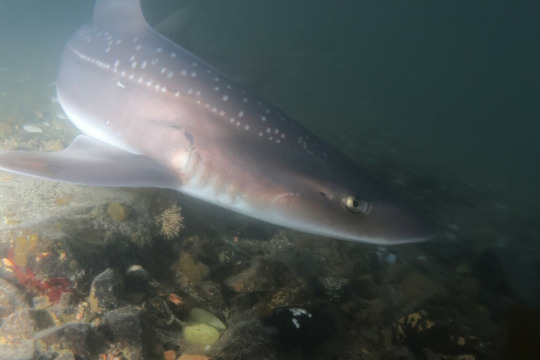
- Spotted Estuary Smooth-Hound at Wellington, New Zealand. Photo by Luca Davenport-Thomas
The researchers believe the noise may come from the sharks snapping their flat, plate-like teeth, a trait adapted for crushing crabs and other hard-shelled prey. Though the exact mechanism remains unconfirmed, and it’s still unclear whether these clicks are intentional or simply a reflex, the finding opens new questions about acoustic behaviour in sharks. Similar clicking has been observed in rays and mantas, hinting that this might not be such a rare trait after all. So yes, that’s the sound a shark makes, and it might just be their version of “back off.”
Reference: Nieder et al., 2025. Evidence of active sound production by a shark R. Soc. Open Sci.
2K notes
·
View notes
Text
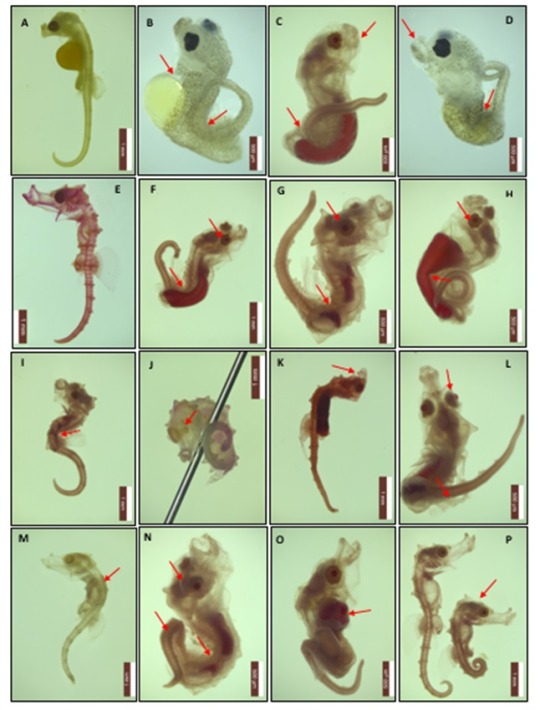
OIL SPILL MAY CAUSE DEFORMITIES IN NEWBORN SEAHORSES
The 2019 oil spill that devastated Brazil’s northeastern coast continues to have far-reaching ecological consequences. A recent study published in Environmental Toxicology and Chemistry examined the impact of the spill on the long-snout seahorse (Hippocampus reidi), a species that relies on stable coastal habitats for reproduction. Researchers from the Instituto Hippocampus monitored seahorse populations in Pernambuco and found a striking difference between two sites: while offspring from the Massangana River estuary (an apparently unaffected area) showed no abnormalities, those from Cocaia Island (a heavily contaminated site) exhibited severe malformations, including spinal deformities, facial abnormalities, and growth deficiencies.
The study suggests that exposure to toxic hydrocarbons from crude oil may have affected the species in two ways. First, long-term contamination likely caused genetic mutations in reproductive cells, leading to developmental defects in newborns. Second, the spill drastically reduced the adult seahorse population, creating a genetic bottleneck that increased inbreeding, amplifying harmful traits. This combination of pollution-induced mutations and reduced genetic diversity poses a serious threat to the resilience of the species, potentially undermining its ability to recover in the long term.
These findings highlight the urgency of continued monitoring and conservation efforts for seahorses in Brazil. All three seahorse species found in the country are already considered threatened by the IUCN, and additional stressors like oil pollution could push local populations toward extinction. To mitigate these risks, researchers emphasize the need for habitat protection, genetic studies, and financial support to sustain long-term monitoring programs. The case of Hippocampus reidi serves as a stark reminder of how oil spills can have lasting, unforeseen effects on marine life, long after the immediate crisis has passed.
Main photo: Newborns with various deformities. By Instituto Hippocampus
Reference: Silveira et al., 2024. First Record of Malformation in Seahorses Attributed to the Oil Spill off the Brazilian Coast in 2019. Environmental Toxicology and Chemistry
15 notes
·
View notes
Text

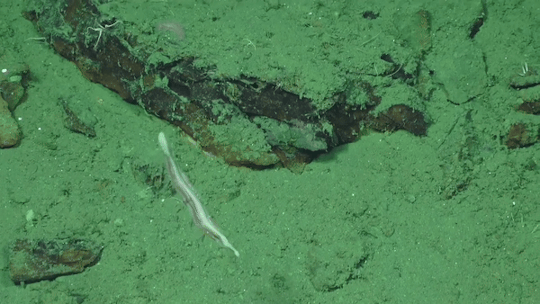
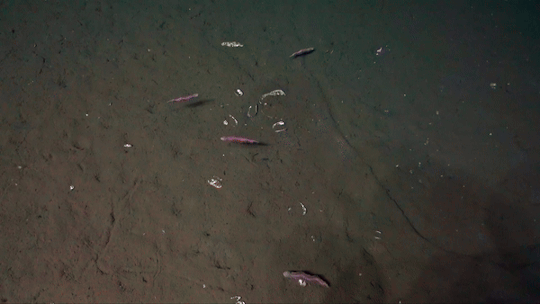
Pectinereis strickrotti is a recently described nereidid polychaete worm found in the coastal waters of the Pacific Ocean, found at methane seeps off the coast of Costa Rica. Specimens of Pectinereis strickrotti had been observed dating back to 2009 swimming just above the seafloor at ~1,000 m depth but were not successfully captured until 2018.
This species is known for its distinctive, fan-like parapodia, which are used for both locomotion, as swimming, and respiration. This polychaete worm inhabits sandy or muddy substrates, where it burrows and forms a protective tube. Its feeding strategy is largely suspension-based, capturing plankton and organic material from the water column using its elaborately branched tentacles. The species plays an important ecological role by contributing to the sediment's bioturbation, enhancing nutrient cycling in its habitat. As a bioindicator, P. strickrotti's presence and health can reflect changes in the quality of coastal ecosystems, especially regarding pollution levels and environmental disturbances.
Gifs extracted from video: Tulio F. Villalobos-Guerrero,
Reference (Open Access): Villalobos-Guerrero et al., 2024. A remarkable new deep-sea nereidid (Annelida: Nereididae) with gills. PlosONE
#Open Access#science#new species#marine biology#nereididae#annelida#polychaeta#blisster#Pectinereis strickrotti#biology#deep sea#pacific#gif
51 notes
·
View notes
Text
youtube
NEW DISCOVERIES ON WRASSES USING TOOLS TO CRACK OPEN PREY
New observations have significantly expanded our understanding of anvil use in wrasses, particularly among South American wrasses, Halichoeres species. This tool-use behavior, in which wrasses use hard surfaces to break open prey, was once thought to be rare and restricted to a few species and locations. However, recent findings from Southern Brazil and the Turks and Caicos Islands indicate that anvil use is far more widespread than previously recorded. Wrasses have been observed using a variety of hard surfaces, including rocks, rubble, and even live conch shells, to crack open crabs, sea urchins, and molluscs, demonstrating remarkable behavioral flexibility.
A key feature of this behavior is its adaptability. Wrasses do not rely on a single anvil or striking point during an event; instead, they are highly opportunistic, shifting between different surfaces as needed. This flexibility enables them to exploit a diverse range of prey and enhances their foraging efficiency. Notably, no strong preference for one side of the body was observed during anvil use, suggesting that wrasses are not lateralized in the same way that tool-using primates often are.

-Sequence of a yellowhead wrasse, Halichoeres garnoti, striking a brittle star arm on rubble by swinging its head from the left to the right
The discovery of anvil use in additional wrasse species suggests that this behavior may be far more widespread than previously believed. To fully grasp the extent of anvil use across various species and regions, further focused research is essential. Controlled experiments offering prey to wrasses could yield valuable insights into the evolution of this behavior, its ecological advantages, and its broader evolutionary significance.
video: A yellowhead wrasse (Halichoeres garnoti) cracking open a brittle star to access the meat inside, using rocks and rubbles, and even a live conch, by C.E. O'Brien
Reference (Open Access): Tariel-Adam et al., 2025 Tool use by New World Halichoeres wrasses. Coral Reefs
37 notes
·
View notes
Text
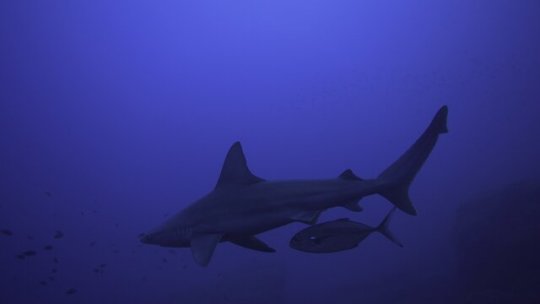
HIDING IN PLAIN SIGHT: HOW BLUE RUNNERS USE SHARKS TO HUNT
Predators have evolved countless strategies to improve their hunting success, from camouflage to coordinated attacks. A recent study has revealed a particularly intriguing behaviour in the blue runner (Caranx crysos): shadowing sandbar sharks (Carcharhinus plumbeus) to get closer to prey undetected. By swimming just beneath the sharks, these fish avoid triggering the usual alarm responses in their prey, allowing them to strike with greater efficiency. This behaviour was observed using baited remote underwater video (BRUV) and dive-operated video (DOV) surveys around Lampione Island in the Mediterranean. When blue runners approached prey on their own, the fish quickly formed defensive schools. However, when they used sharks as cover, the prey’s reaction was delayed or even absent, significantly increasing the blue runner’s chances of a successful hunt.
This discovery not only sheds light on a new form of predator-prey interaction but also highlights the ecological importance of large marine predators. While the sharks themselves seemed unaffected by the blue runners' presence, their role as unwitting partners in this hunting strategy suggests that declines in shark populations could have unexpected ripple effects on associated species. As intense fishing continues to reduce shark numbers worldwide, such behaviours may become rarer, potentially altering the dynamics of marine food webs in ways we are only beginning to understand.
Reference: Cattano et al., 2025. To see and not be seen: Carangids hide behind sharks to prey on fish. Ecology
391 notes
·
View notes
Text

SHARKS WITH A MEMORY: NEW EVIDENCE OF REPEAT OFFENDERS
For years, the idea that individual sharks could be responsible for multiple predatory bites on people remained unproven. However, a recent study has provided the first solid evidence that some sharks, particularly tiger sharks (Galeocerdo cuvier) and oceanic whitetip sharks (Carcharhinus longimanus), have exhibited repeated attacks on humans. Using genetic analysis and photographic identification, researchers identified individual sharks involved in multiple incidents. This challenges the traditional view that shark bites are random events driven solely by mistaken identity or environmental factors.
The concept of "problem individuals" has been widely accepted in terrestrial predators like lions or bears, but its application to marine predators is groundbreaking. In one documented case, an oceanic whitetip shark in the Red Sea was linked to multiple attacks on swimmers. The study suggests that some sharks may learn to associate humans with food, especially in areas where baiting or fish feeding occurs, leading to more frequent interactions and potential aggression. While shark attacks are rare, this discovery highlights the importance of studying individual behavior rather than assuming all sharks of a species behave the same way.
This finding has significant implications for ocean safety and shark conservation. Rather than resorting to widespread culling, a more targeted approach—such as monitoring high-risk individuals or limiting human activities in areas where they have been identified—could help reduce incidents while protecting these important predators. Understanding shark behavior at the individual level may be the key to coexisting with them in their natural environment.
Main photo: Photo‐identification of the “problem” female tiger shark “Lagertha.” Photo courtesy of M. Hunkel, J. Spaet, C. De la Cruz, and S. Boaz
Reference (Open Access): Clua et al., 2024. First Evidence of Individual Sharks Involved in Multiple Predatory Bites on People. Conservation Letters
#Galeocerdo cuvier#Carcharhinus longimanus#sharks#biology#marine biology#marine science#elasmobranch#science#sciblr#ocean
51 notes
·
View notes
Text

CAN FISH RECOGNIZE INDIVIDUAL HUMANS IN THE WILD?
The ability to recognize individual humans is often associated with mammals and birds, yet research suggests that some fish are also capable of this cognitive feat. While diving in the Mediterranean Sea, a team of scientists observed something intriguing: every field season, they were followed by groups of local fish known as pargo or dorado, stealing food intended to reward other fish in their experiments.
In controlled experiments, wild saddled sea bream (Oblada melanura) and black sea bream (Spondyliosoma cantharus), were trained to follow a human diver to obtain a food reward. Remarkably, they can differentiate between dozens of individuals with high success rates, even when superficial features such as colour or brightness are altered. This suggests that their recognition is based on specific patterns rather than simple visual cues. Similar capabilities have been observed in cleaner fish (Labroides dimidiatus), which adjust their behaviour depending on whether they recognize a familiar diver, implying that this skill might have adaptive benefits in natural environments.

-Maëlan Tomasek (Max Planck Institute of Animal Behavior), one of the study's authors, next to a wild fish. The researchers found that wild fish start to follow humans for food and are able to identify individual divers by their clothing.
If fish in the wild can recognize individual humans, the implications extend beyond academic curiosity. Species frequently interacting with humans—such as those in ecotourism settings or research projects—may learn to associate specific individuals with positive or negative experiences. This has been observed in sharks, where some individuals appear to recognize divers who regularly feed or tag them, approaching more readily or avoiding interactions depending on past encounters. Understanding these cognitive abilities could inform conservation strategies by highlighting the impact of repeated human interactions on fish behaviour.
Despite these insights, much remains unknown about how fish process facial recognition and whether this ability is widespread across different taxa. Future research will need to examine whether this recognition occurs naturally in the wild without training and how it influences social interactions within fish populations. As we continue to challenge outdated assumptions about fish intelligence, it becomes increasingly clear that their cognitive world is far more complex than previously thought.
GIF: Trained fishes following diver
Reference (Open Access): Maëlan et al., 2025. Fish use visual cues to recognize individual divers. Biol. Lett.
#Spondyliosoma cantharus#Oblada melanura#fish#biology#science#sciblr#scienceblr#marine biology#ethology#behavior
1K notes
·
View notes
Text

HOW BLUE WHALES WHISPER TO EVADE ORCAS
In the vast ocean, even the largest whales are not safe from predators. Orcas regularly attack and prey on baleen whales, especially their calves. In response, baleen whales have evolved two main strategies: fight or flight.
Slow-moving species such as humpbacks, right whales, and bowheads form tight groups in shallow waters, defending their young through coordinated efforts. In contrast, fast-swimming species like blue, fin, and sei whales avoid confrontation by staying in the open ocean and fleeing at the first sign of danger. But evading predators is not just about movement—it also shapes how these whales communicate.
Male baleen whales sing to attract mates, but for flight species, singing too loudly could mean drawing in orcas. Orcas cannot hear sounds below 100 Hz and detect only very loud calls below 1500 Hz. A recent review found that most fight species (89%) produce calls above 1500 Hz, making them easy to hear. Flight species, however, rely on lower frequencies and quieter calls, reducing the risk of detection while still reaching distant mates.
This strategy, known as acoustic crypsis, allows flight species to communicate without exposing themselves to predators. Blue whales, for example, produce their loudest calls below 80 Hz—well below orcas’ hearing range. By whispering through the ocean, these whales navigate the delicate balance between reproduction and survival.
Photo: Jafet Potenzo Lopes
Reference: Branch. 2025. “flight” baleen whale species are acoustically cryptic to killer whales, unlike “fight” species. Marine Mammal Science
#whale#blue whale#cetacean#orca#Balaenoptera musculus#orcinus orca#science#marine science#biology#marine biology#sciblr
28 notes
·
View notes
Text

NEW SIGHTINGS OF THE DIAMOND STINGRAY IN CHILE: A HIDDEN SPECIES REVEALED WITH HELP FROM FISHERMEN
The diamond stingray is easily recognized by its diamond-shaped body, smooth skin with few spines, and long tail armed with a venomous barb. This species has a broad distribution, ranging from southern California to northern Peru, where it is relatively common. However, until recently, its presence in Chile was only known from a single record dating back to the 1980s.
Thanks to photographs shared by recreational shore fishermen, the presence of the diamond stingray has been confirmed along the entire Peruvian coast and the northernmost regions of Chile. Researchers used social media platforms to search for photographs of rays and sharks, identifying that this species had been regularly captured in the region. By combining these new sightings with historical distribution data, scientists employed ecological modeling tools to predict the potential habitats of the diamond stingray in its southern range.
While this discovery confirms the presence of the diamond stingray in Chile, it also raises new conservation concerns. This species is not currently protected by Chilean legislation and faces several threats, including habitat destruction, entanglement in fishing gear, and overfishing due to its slow growth and low reproductive rates. The species is listed as Vulnerable by the IUCN, highlighting the need for increased conservation efforts. Fishermen and divers who contribute photographs through social media serve as valuable sentinels, providing critical data for researchers, but much about the ray’s ecology and the specific threats it faces in Chile remains unknown. Further research and targeted conservation strategies are needed to safeguard this species and its newly identified habitats.
Photo: Oceanfreaks Dive Center
Reference: Almendras et al., 2024. New evidence confirms the presence of the diamond stingray Hypanus dipterurus (Jordan & Gilbert 1880) in Chile and extends its southern range. Journal of Fish Biology
#dasyatidae#elasmobranch#science#hypanus#hypanus dipterurus#chile#pacific#biology#marine science#marine biology
23 notes
·
View notes
Text
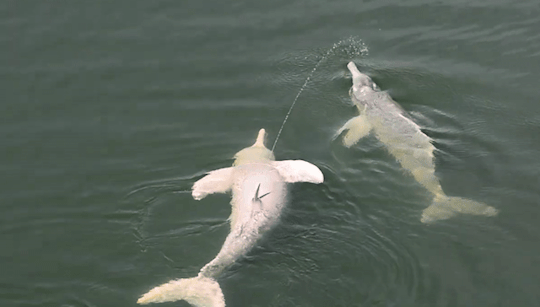
MALE AMAZON RIVER DOLPHINS MAY COMMUNICATE VIA AERIAL URINATION
Dolphins are known for their complex social behaviours, but a recent study on Amazon river dolphins or botos (Inia geoffrensis), has revealed a striking and previously undocumented behaviour: aerial urination. Unlike most mammals, which urinate discreetly in water or on land, male botos sometimes position themselves upside down and expel a stream of urine into the air. This behaviour appears to have a social function, as other males often approach the urine stream with their rostrum, suggesting they may be detecting chemical cues.
Urine-based communication is well established in terrestrial mammals, where scent marking plays a key role in mate selection, territorial defence, and social interactions. However, chemical communication in aquatic environments is much harder to study, partly because water quickly disperses chemical signals. While some fish and crustaceans use urine pulses for social interactions, cetaceans were not previously thought to rely on this mechanism, especially since they lack a well-developed sense of smell. The observations of aerial urination in botos challenge this assumption, raising the possibility that these dolphins have evolved an alternative way to detect chemical cues.
The study, led by CetAsia Research Group in Ontario, Canada, proposes that botos may use the bristles on their rostrum—structures previously linked to touch sensitivity—to detect chemical compounds in urine. This would mean that dolphins, despite their reduced olfactory abilities, might still gather information about other individuals through chemical signals. The behaviour was recorded in social contexts involving males, hinting at a role in dominance interactions, sexual competition, or even cooperation within groups.
This discovery opens new questions about sensory perception in aquatic mammals. If river dolphins have found a way to extract social information from urine, could other cetaceans do the same? And if so, how widespread is this form of communication? As research progresses, what once seemed an unusual behaviour may prove to be a crucial part of social life in these enigmatic river dolphins.
GIF: Drone footage showing aerial urination, by Claryana Araújo-Wang
Reference: Araújo-Wang et al. (2025). Aerial urination suggests undescribed sensory modality and social function in river dolphins. Behavioural Processes, 105149.
#Amazon river dolphins#Inia geoffrensis#cetacean#biology#freshwater#science#sciblr#bioblr#golden shower#behavior#boys will be boys
451 notes
·
View notes